





As the May Issue of the Harbinger is released, I have to say thank you for any and all feedback the readers have given us this year. As student journalists, we aren’t perfect. We’re learning and growing as each issue is made.
The public eye can be a harsh reality. When we mess up, we hear about it. But that’s what helps us to grow. Comments made about our work are meaningful.
Not only do I appreciate feedback, but genuinely, it means a lot to the Harbinger staff anytime someone reads these magazines. You’re not only supporting the journalism program here at Zionsville but all of us aspiring journalists will use the skills we're building no matter what career path we follow.
And speaking of those journalists, I just have to say thank you for an amazing year. Being your editor has been tough but so worth it. I see so much potential in all of you and each of you never fails to impress me with your creativity.
Each Harbinger staff member has come up with ideas no one else could have thought of, bringing your own thoughts, opinions, and critiques to the table. I hope you continue to be the way you are now, so impressively creative, funny, and just such a family.
I’m going to miss Harbinger so much. However, I’m excited about what the Harb will look like in the future. I can’t wait to read your work! I already know I’ll love it.
As school comes to a close, we gain more time in our schedules; time to relax, breathe, and take a break. But there are some benefits school comes with that cannot be accessed over the summer. The school provides us with the guidance of teachers, counselors, or other adult figures. It’s a way to find our support system, one that we know we’ll have at least five days a week. And, suddenly, over summer the support system you’ve built is gone.
So this is why, right now, before school even ends, it’s important to plan out your summer. It doesn’t have to be anything planned out down to the day or even the hour, but some structure can be helpful. Think about what adult figure you can talk to for guidance over the summer. Who will be your support when your favorite teachers or counselors are not available or your friends are on vacation?
While we can’t tell you what emotions you’ll feel over the summer, one thing we know that is ever-present throughout the summer is the feeling of missing out (fomo). This means feeling left out when you see what things others are doing. And many of these feelings can turn into summer burnout. On pg. 15, we dive into this topic and give suggestions as to how you can solve this problem.
Editor in Chief
Mary DeMarco
Assistant Editor
Madeline Wilson
Copy Editor
Adanna Mbanu
Art & Graphics Editor
Brooklyn Brown
Social Media Editor

Amelia Loewer
Design Editor
Josie Brackett
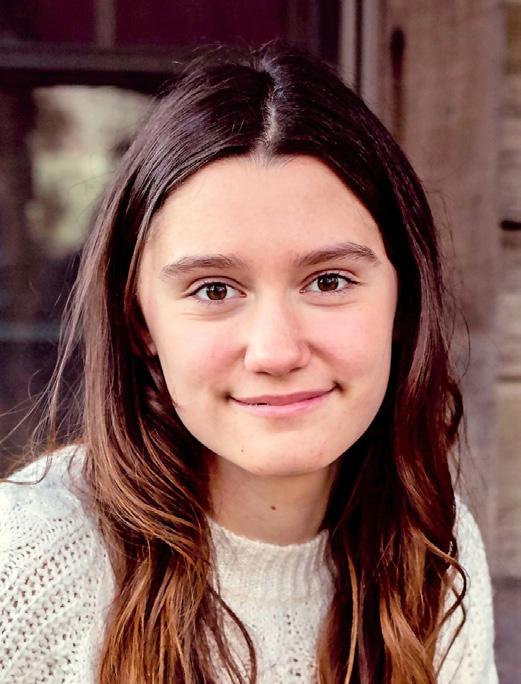
Staff:
Lauren Burch
Emma Hummer
Amelia Meyers
Georgianna Moreland
Matthew Orbaugh
Greta Reed
Lilly Steele
Ellie Vanderbur
Marissa Villarrubia
So yes, summer can be an amazing time. But what often goes unspoken are the struggles people can go through in summer. Be conscious of this and look for your support group even in the summer. Take time for yourself and do what’s best for you!
The mission of the Harbinger is to provide timely, relevant, and interesting content, while handling topics with respect and objectively. Harbinger aims to reflect the diverse nature of the student body of ZCHS by including those of all walks of life in the publication. The Harbinger serves as a public forum and invites letters to the editor and communication from others. The Harbinger is student-run and opinions in the magazine do not necessarily represent those of ZCHS or Zionsville Community Schools.


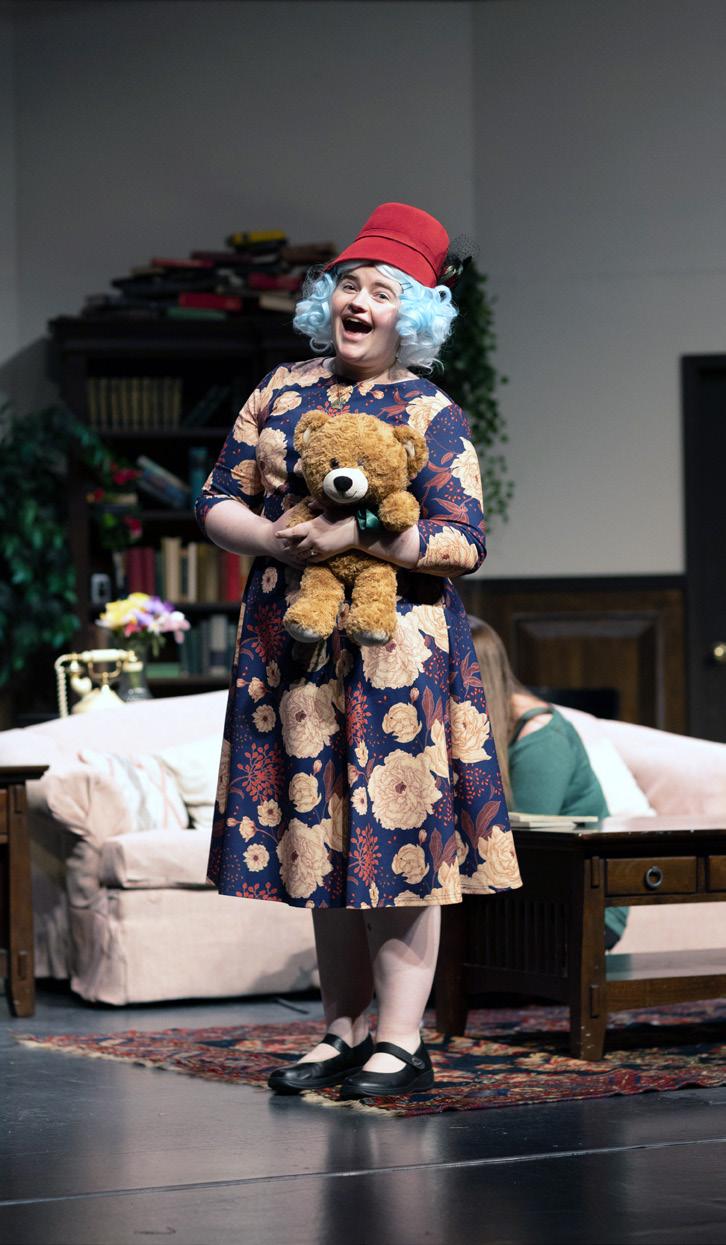


According to the Trevor Project, a nonprofit group focused on LGBTQ+ youth mental health, 62% of LGBTQ+ youth across Indiana could who wanted help with their mental health were not able to get it for fear of not being taken seriously or understood, the lack of money to pay for support and, the lack of parent permission or acceptance or the fear of it not helping.
Eli Aldrich, at Brebeuf Jesuit High School is the executive director of Shelly’s Voice Advocacy, a nonprofit organization currently operating in Indianapolis.
Shelly’s Voice was founded in August of 2018 when teacher Shelly Fitzgerald was fired from Roncalli High School, a private school, for being married to a woman.
Shelly’s Voice works with Indiana Youth Group to provide services for LGBTQ+ youth such as mental health support, pen pal programming and other resources.
“Shelly’s Voice primarily acts as an advocacy wing and provides holistic programing, responsible advice and leading resources to LGBTQ+ youth in the state of Indiana,” Aldrich said. “They also work with their youth advocacy team to amplify the voices of LGBTQ+ youth across the state.”
Aldrich’s sister, Madison, went on the Ellen Show to speak about the injustice Fitzgerald faced. That video now has 645,000 views.
“One of the biggest ways that we’re able to organize and amplify our voices is through the media. And to date, the Ellen Show has been our largest publication, as an organization and it was really exciting to be able to see my sister on that show,” Aldrich said.
However, though there are many advocacy groups, LGBTQ+ youth have still been
discriminated against, which can take a toll on their mental health.
According to the Trevor Project survey, 73% of LGBTQ+ students have experienced discrimination in the past year.
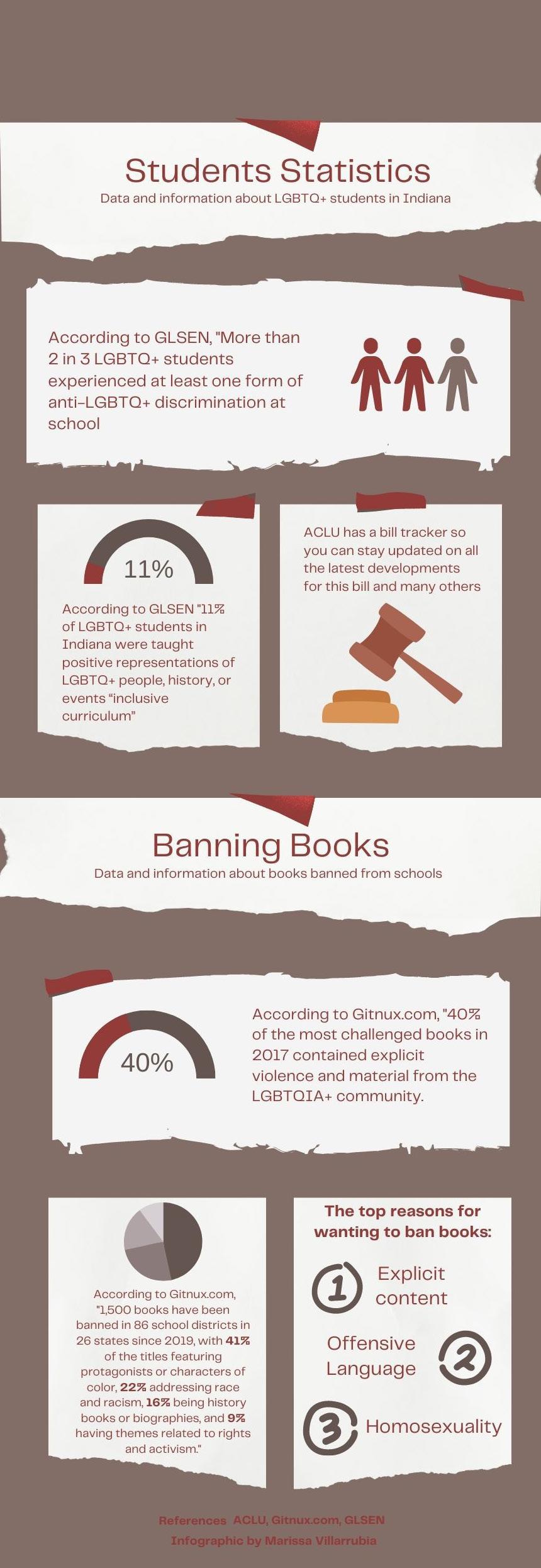
Sol Chen, 11, is outgoing with their fashion choices and has had both positive and negative comments.
“There are a few people who have said negative things. I’ve quite literally been called delusional before. People purposely have used my legal name against me. It’s kind of less common compared to people who have supported me. I do get a little more invalidating comments, especially with how I still dress pretty feminine, despite being trans-masculine.”
As of April 30, Indiana House Bill 1608, a bill that requires teachers to notify parents within five days if a student requests to use a different name or pronoun at school, is awaiting the signature or veto of Governor Eric Holcomb.
Aldrich said having representation at school “is very important for the youth’s mental health and their image of themselves.”
Another bill awaiting a decision from Holcomb is HB 1447. This bill would require schools to have a review process if a parent or community member objects to a book being offered at the school library.
Books with LGBTQ+ characters or themes may be the target of such objections.
“LGBTQ+ youth historically have been able to find lots of support within their school, whether that’s a teacher, other queer students, or parents,” Aldrich said. “A school has acted as a safe space.”
The sound of drilling rings throughout the west end of the school as construction continues on the previous main cafeteria where the school will be adding new classrooms. This is in addition to additional features in the new Eagle Commons dining space, as well as welcome changes to parking.
New changes have been coming left and right, and next year’s students will be looking at an almost completely revamped school. This year, the school has already unveiled new classrooms, several new common spaces and a new cafeteria that holds around onethird of the student body.
This raises the question: what are the plans for the previous three cafes?
Matt Walter, assistant principal, said that new business and art classrooms are being constructed, replacing what used to be the old main cafeteria.
“The art rooms are in the front,” Walter said. “The business classrooms are towards the back of the old cafeteria where the kitch-
en used to be.”
In addition to some teachers moving to the new classrooms, many teachers will also be relocating throughout the school to be more closely connected to their departments. For teachers and students, moving classrooms can be stressful.
English teacher Mica Wilson is one of the teachers switching to a different classroom, W404. She has been in her current classroom for three years.
“As soon as you know where you’re going to be spending the majority of your waking hours,” Wilson said. “Then everybody seems pretty okay.”
These plans aren’t finalized and are subject to change as administration decides what will fit and work best for the school as a whole.
“The 400 [hallway], has English teachers and social studies teachers in it,” Walter said. “It will be all social studies teachers next year.”
The science department will also be receiving five new labs/classrooms on the West end of the building with a completely “new and modern” design, according to Walter.
“Whether you’re having regular class or lab, instead of the little peninsula that sticks out, that part moves,” Walter said. “They’re kind of big open rooms.”
Michael Dollens, who teaches Integrated Chemistry and Physics (ICP) and Physics I, is one of the science teachers who is going to be moving into the new science labs. The labs are located near the West commons and have a more modern look.
“I’m excited for the new room. It’s new, it’s shiny, and more centrally located,” Dollens said. “Right now kids coming from Armentrout and Anderson’s 700 hallway don’t have a chance to be on time in my class.”
The school has a passing period of seven minutes so the majority of that time, if not all, is spent walking from each of your classes. Next school year, a new hallway connecting to West end of school to the East end will open up, making crowded conditions less common during passing periods.
In the center of this seven minute walk is the new cafeteria, easily accessible for all sides of the school.
Students will notice changes to traffic outside of school as well, as buses will move their pick up and drop off to Mulberry Street. This will reopen the parking lot closest to Door 17 to students and staff.
The student body hasn’t been formally introduced to all of the new aspects of the cafeteria yet, such as the coffee shop and outdoor space. While the outdoor space is expected to be available this school year, the coffee shop is not set in stone.
“It’s got a lot of potential but we don’t have any specific [plans],” Walter said.

Swoosh! The green flag drops and the racers are off, one by one they zoom past the smoked corners of the race track seemingly faster than the speed of light. The fans holler and cheer with excitement but their voices are muffled by the roaring of the engines. You stand there amazed, never before have you seen cars go so fast. How is it possible for a car to be built for such speed?
That was the question that inspired Cragg Steele’s love of racing in 1946. Steele is the grandfather of freshman Lilly Steele.
“I was just in awe,” C. Steele said. “Machines went so fast and made so much
On weekends you can find Junior Nico Haydar biking more than you may travel by car in a day. But he didn’t start bike racing until later in his life. In fact, Haydar didn’t get his first road bike until age fourteen.

He was quick to throw himself into biking world.
“About a year into cycling,
noise, it amazed me. The drivers became my heroes.”
Although the drivers are seen as the heroes of the race, in reality, success is held together by the mechanics, constructors, and pit crew of the team.
After working with cars in the Indy 500 industry, Steele created his own race team of race car creators and passionate race fans. Throughout the year you can find them working together to design and build midget cars to prepare for the upcoming race season.

“Every car we build is different but the
I joined my first team,” Haydar said.
Now, he said he will always be on a team. Currently, his team is for juniors only. The Cleveland Cycling Academy team is a cycling team that travels around the mid-west to race.
“It’s a developmental team to try to develop kids into better riders,” Haydar said.
The racing Haydar does is called closed circuit, which means racing laps on roads that are closed to traffic.
“It’s very similar to car racing,” Haydar said.
goal is all the same, to create a car that’s going to be the fastest, which takes a lot of work so everyone does their part,” C. Steele said. “I order the parts, put them together, and design the car from scratch. Then my team will paint the car panels and secure the car parts together.”
Once the car is tested and ready to drive, it’s up to the driver to bring home the win.
“That’s the icing on the cake; seeing your car out there on the track,” C. Steele said. It really makes the long hours and constant headaches from working on it worth it to both you and your team.”
Outside of his team, Haydar said that his biggest accomplishment was biking 160 miles at once, which for Haydar equates to about eight hours.
Senior Dana Radentz may not be racing against any other rider across the hoove paved course, but she regards cross country riding as a race of its own.
Radentz said the event is “not like typical racing because it’s just you and your horse, but it’s similar.”
Cross country equestrianism is one of three equestrian events; the others are dressage and show jumping. The event is designed to test the horse’s jumping ability and endurance through
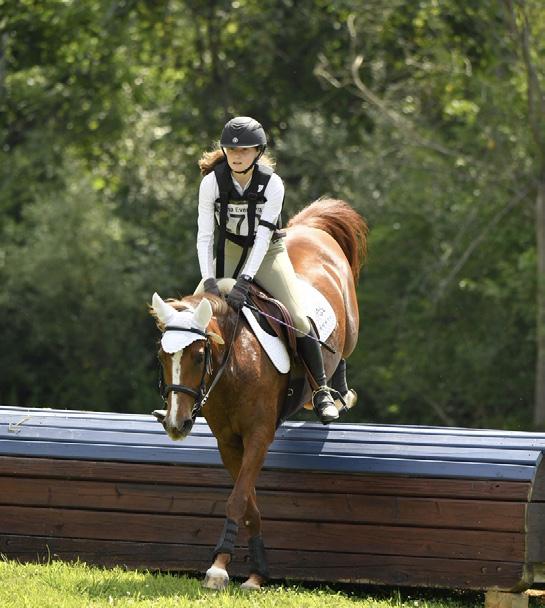
a 6 km long course where the horse must jump over a number of fixed and solid obstacles laid throughout a field within a fixed time limit.
“There’s like a minimum and maximum time interval you have to get inside in order to get no deductions,” Radentz said. “It’s definitely to prevent people from just strictly going super fast.”
Combined with the strict time limit and a number of obstacles, injuries and penalties are an easy ticket, which makes
cross country riding the most dangerous out of the three events. However, recent changes to the course in regards to the rider and horses safety have made the event less threatening. Radentz considers the event to be her favorite.
“It’s the most unique event and it’s just a lot of fun going out there and cantering and jumping,” she said. It’s something I would encourage anyone to try if they’d be up for the challenge.”
While dance is not like other sports, it is different in less obvious ways that people may not see.
Sam McMahon, senior, is a competitive dancer at Expressenz Dance Studio in Carmel.
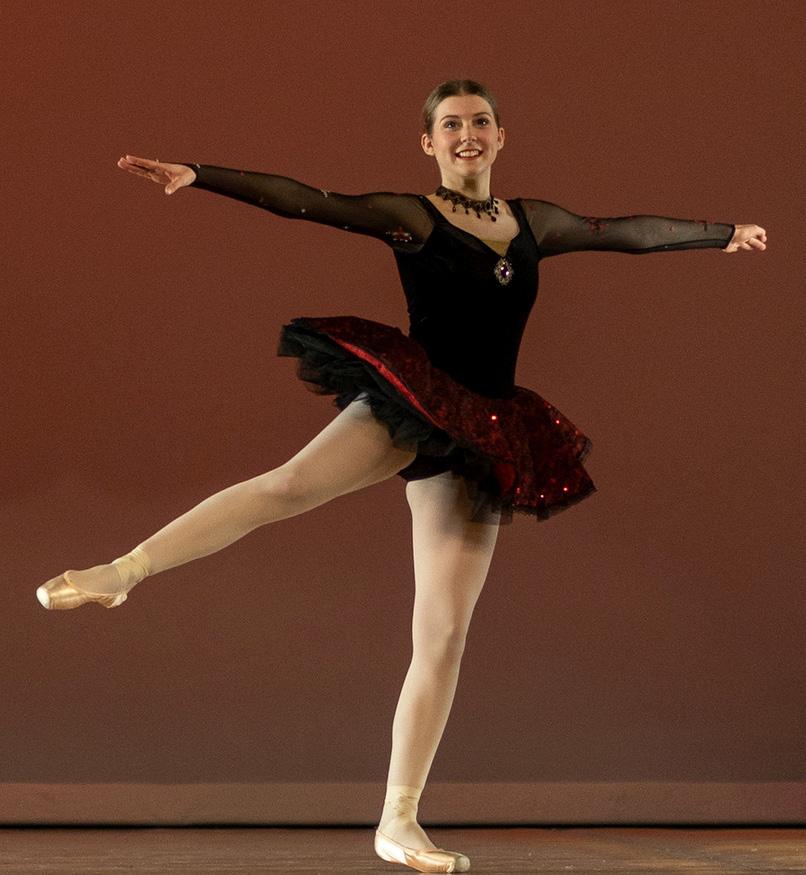
McMahon said a common misconception people make about dance is that it is simple.
“[Dance] gets very oversimplified, but then people also see Dance Moms, and they think it’s crazy,” McMahon said. “There’s a lot of different ways and forms you can do it. You can do it at this insane level, or you can do it for fun. It doesn’t have to be one
or the other.”
Junior Emma Phipps, a dancer with Village Dance Studio, said dance is a “huge time commitment.”
“Trying to balance it with school is probably the hardest part,” Phipps said.
Ensemble dancers at Village Dance Studio are typically required to take at least two ballet classes and two other styles of dance a week. More advanced dancers are required to take two or three pointe classes along with a ballet class every day.
McMahon is at the dance studio from 4:30 to 9:45 p.m., Monday through Thursday and from 9 a.m. to 3:15 p.m. on Saturdays.
After spending 30+ hours a week at the dance studio throughout the year, McMahon looks forward to the end of competition season.
“I love performing; it’s so fun to be able to bring joy to people and be able to show off what I can do,” Meredith Stehr, junior and a dancer with Village Dance Studio, said.
While people think that dance is mostly a physical exercise, it often becomes a mental battle, too.
“[Dance] is very competitive,” Stehr said. “Even in recreation dance where
you’re not competing against other people, your brain will automatically compare you to everyone else.”
Stehr said dance is not all about “looking pretty.”
“There are days where you go in, you don’t want to do anything, and you can barely handle it,” Stehr said.
Difficult times tend to show in more ways than one, particularly in the colder months “when people get sick or injured the most,” McMahon said.
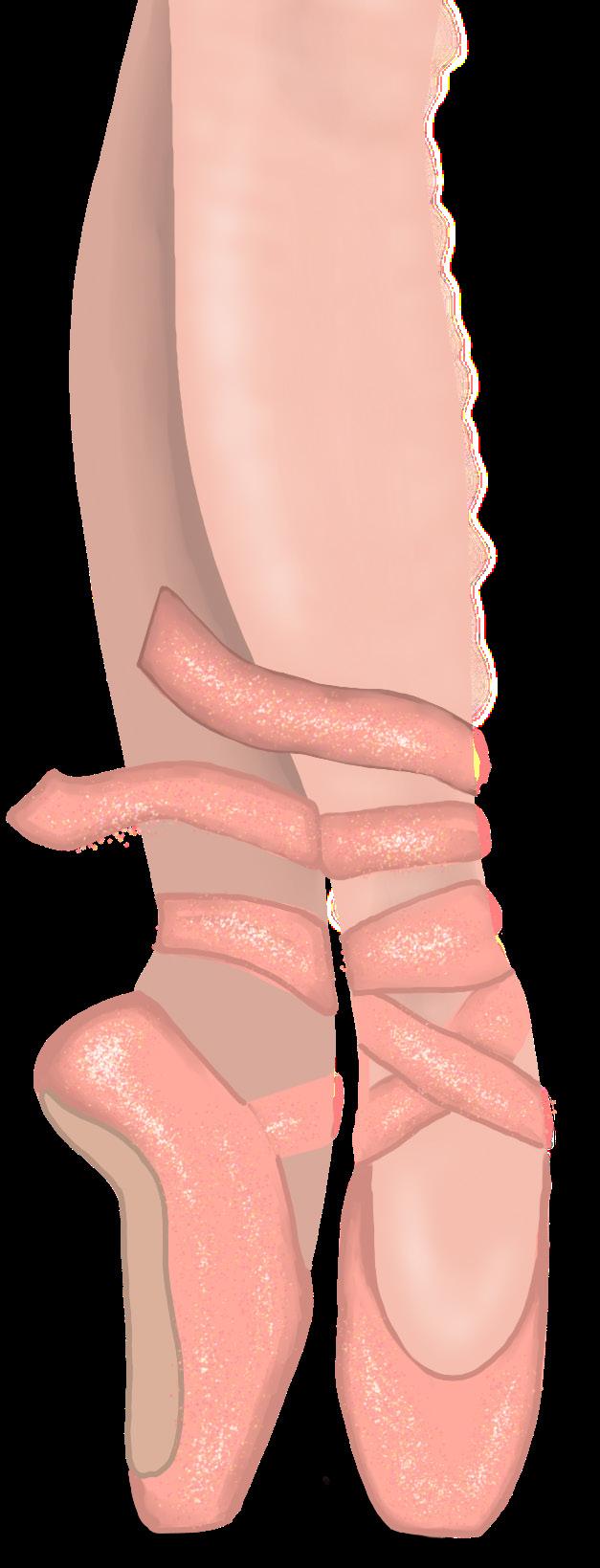
“It’s hard when you have all these people that are missing or sick or injured, being able to still show up for yourself and the rest of your team,” McMahon said.
Everyone has worked equally as hard as the next person to get where they are, Stehr said.
“Towards the end of the season, that’s when all of the insane hours and all the time I spent there pays off. That’s when [I] feel the most reward from it,” McMahon said. “The end of the season is when people come together the most and that’s usually when the dancers are the best, everything looks the best, and everyone’s the happiest.”
Senior Obi Anyanwu has participated in track and field since he was in seventh grade, but this is his first season competing in the long jump.
Anyanwu mostly runs in short distance races, so he said he is still adjusting to the new event.
“I’m trying [long jump] for the first time this year, so I’m trying to get a grasp on it,” Anyanwu said. “I’m still trying to get my form down.”
One of Anyanwu’s goals for the season is to improve his long jump through practice. But even more than beating his records, Anyanwu said he likes getting to watch his teammates’ events.
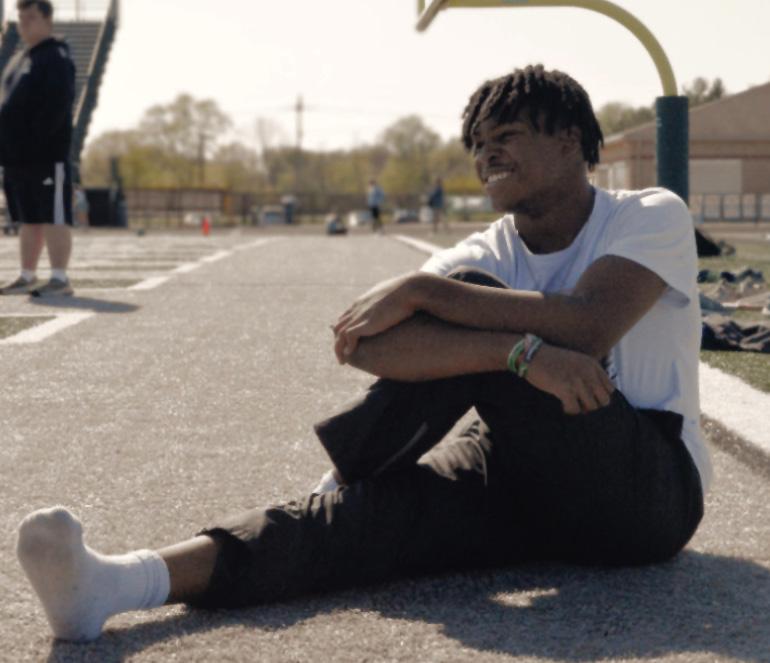
“My favorite part of track is definitely just going to the meets, watching my friends and other people on my team run, cheering them on, and just having a fun time,” Anyanwu said.
In her first season on the track and field team, freshman Macie Hanson is already placing high in her favorite event: high jump.
“It feels good when you can get over the bar,” Hanson said. “I’m more proud for high jump because it’s harder to do than my other events.”
Hanson also likes high jump because of the time she spends with friends and the support from her coaches.
“I like that I have a coach who can tell me what to do and help me get better,” Hanson said.
Despite her early success, placing first in the first meet of the season, Hanson was still excited for the rest of the season.
“I’m looking forward to improving and just doing better with all of my events,” Hanson said. “I’m also looking forward to all the meets, to get to spend with my friends.”
Last September, sophomore Abigail Deaton switched from high jump to pole-vaulting after her coach suggested that she try it. Since pole-vaulting is a smaller event than most other events, Deaton feels pressure from the group of five participating, trying her best to be the leading pole-vaulter in her event.
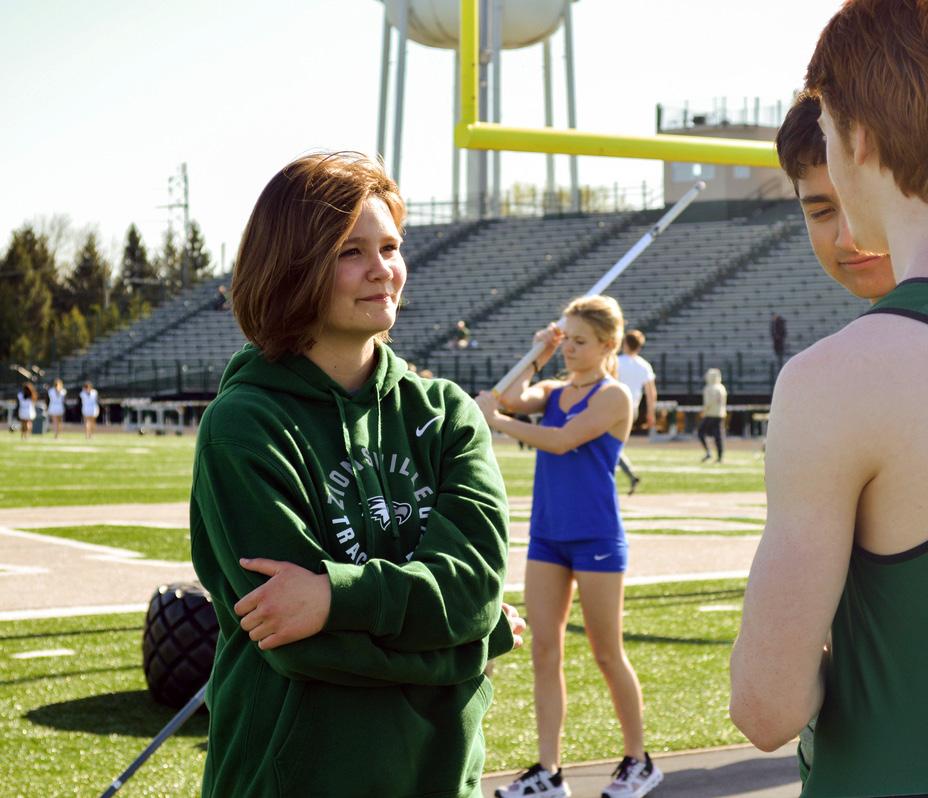

“There’s not a lot of people in the event, so it’s a higher pressure trying to stay at the top,” Deaton said.
With the group of pole-vaulters being so small, the event tends to be overlooked by most of the crowd.
“I’d say in general that field are definitely overlooked compared to events like sprinting or hurdles,” Deaton said. “I personally don’t really mind it, because I don’t like that much attention. But some people would definitely feel different about it.”
Although Deaton doesn’t mind the lack of attention the event receives, she does comment about how long the practices are, saying that can go for around three to four hours, making it “inconvenient.”
Overall, Deaton’s seasons while pole-vaulting have been “fun”, commenting that she “likes the coaches and the connections she’s made.”
Having started discus in sixth grade, junior Finn Essley has met people that have supported him throughout his six high school track seasons and summer seasons.
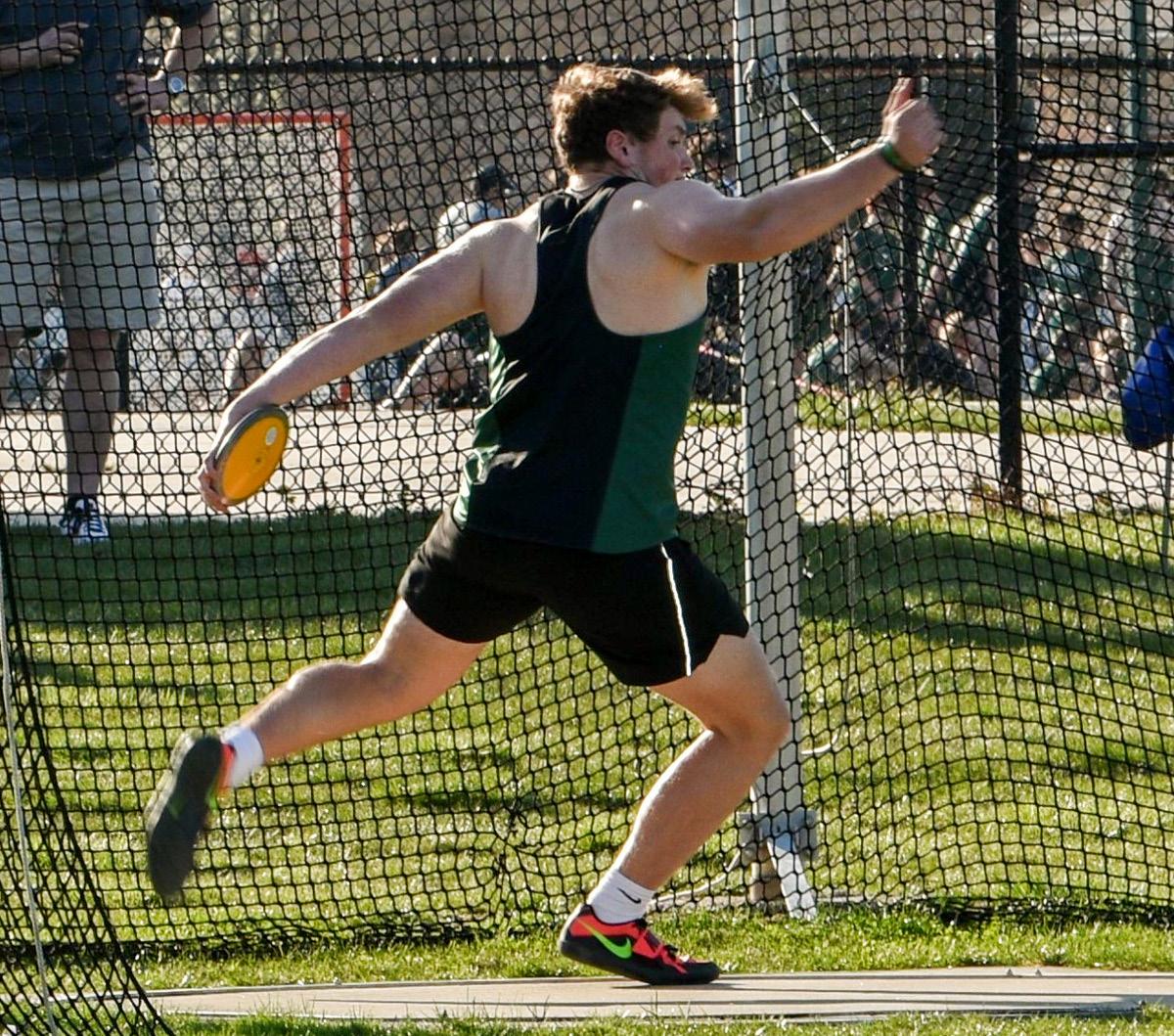
“I’ve made a lot of bonds with people that I wouldn’t have otherwise met,” Essley said.
When the summer track seasons hits, Essley travels all around the country to do the event that he loves.
“When you play for high school, you’re just going to other high schools across the state, but over the summer you travel all over the country,” Essley said. “The farthest I’ve traveled is either Florida or North Carolina.”
Essley said his biggest accomplishment throughout his seasons was either qualifying for sectionals and regionals last year or breaking the sophomore record for discus. But behind all of these honors, Essley occasionally experiences burnout.
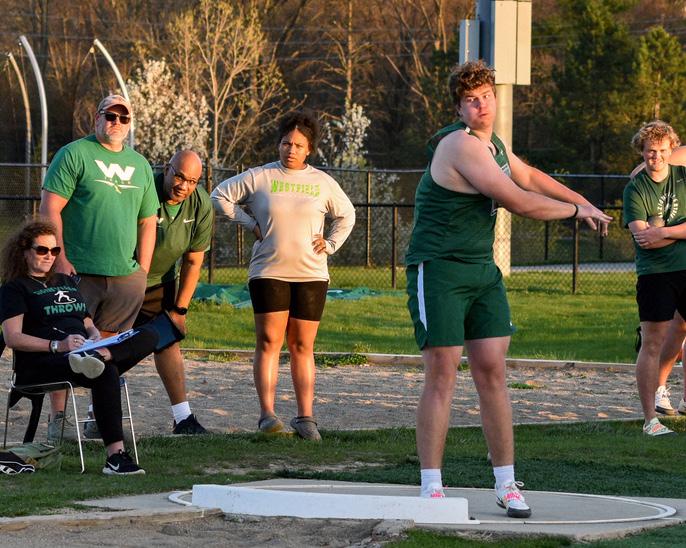
“Just staying committed can be hard when you’re going through a slump, trying to stay right mindset and stay positive,” Essley said. “But you just have to grind through it until you start figuring things out again.”
When junior Jack Shertzer joined the track and field team this spring, his choices of shot put and discus were influenced by his experience as a lineman on the football team.
“We’re primarily focused on being strong rather than being fast,” Shertzer said. “I figured shot put would be better for me.”
Even without the teamwork that is integral to football, Shertzer said there is still a lot of camaraderie in the team and the different events.
“You can cheer, even for the other team,” Shertzer said. “When another thrower from another school has a good throw, we’ll congratulate them.”
Shertzer hopes to become one of the team’s top throwers by the end of the season, with the ultimate goal of going to State.
“I want to continue to progress. Since it is my first year, I’m just trying to get better and better,” Shertzer said. “I don’t know if [State] is a realistic expectation this year, but that would be the goal for especially next year.”
Sophomore Mary Stone has been running track since sixth grade, but never truly found her love for hurdles until two years later in eighth grade. Stone used numerous variations of “trial and error” to figure out what event she strived at.
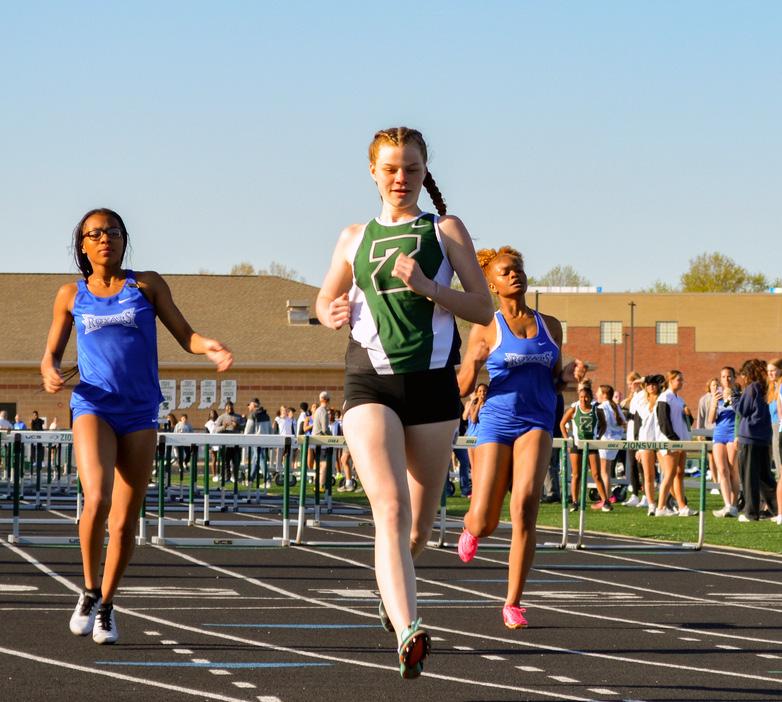
Through her seasons in middle and high school, Stone says that her biggest accomplishment was qualifying for sectionals as a freshman.
“[The experience] was stressful because I’ve never done it before,” Stone said. “But it was a fun experience since I got to see the other side of competition.”
Stone’s seasons have been strong, but at the beginning of her freshman year, she found a struggle with switching coaches from middle school.
“The changes of coaches [was difficult] at first,” Stone said. “But the coaches [in high school] are better because they give you more guidance on what you need to do, and what we’re doing wrong and how to fix it so that we can improve.”
Stone suggests that everyone should experiment with different events that they’d like to do because “you’ll never know if you don’t try it.”
Throughout the school, blue recycling bins can be seen near printers, the Commons, and other areas. But this wasn’t always a common sight at ZCHS; the recycling bins were put in place only this year. And although many may think it was a decision made by administration, it was four AP US History students: juniors Spencer Krone, Payton Bohm, Andrew Raikos, and John Gunderman .

“The original idea for this [project] was from a very convenient series of events,” junior Spencer Krone said. “I was sitting in my bed one morning, looking on Instagram, and I got an ad for National Geographic. They were doing this environmental slingshot project where if you make a video about [an environment-related project], you get a scholarship.”
Eventually, Krone’s idea to create something for National Geographic turned into something more local.
“My dad works for a plastic bottle company,” Krone said. “We decided that we wanted to raise awareness for recycling in the school because we were aware that the recycling at the school is pretty bad.”
According to Krone, the state of ZCHS recycling was nonexistent.
“They took the recycling from [the recycling] bins and put them in the trash,” Bohm said.
Any student efforts to recycle would have
been for nothing.
“Even if you recycled [in] the bins here, they didn’t even go to the recycling plants,” Raikos added.
From there, Krone was able to get friends from his APUSH class involved and the project began.
The first step in taking action was identifying the areas in the school where paper was wasted the most. Bohm recalls that the areas near the printer and near specific teachers’ rooms were in most need of recycling bins.
“We can actually have the school start recycling things, but it will be easier for them,” Bohm said.”
As the project grew, the group even partnered up with a teacher sponsor, choir teacher Samuel Chenoweth.
“The biggest amount of effort was the process of [deciding], where did they want to actually put the bins in the school,” Chenoweth said.
Instead of putting bins in every classroom, Bohm said that putting bins near areas where a lot of paper is thrown away will be an easier transition for the school’s recycling habits.
Once everyone has become accustomed to this new addition, the school can move forward and add more bins to different areas.
Checking the results at the end of the first week, the group found that only four pounds of paper were put into recycling bins.
“It wasn’t a lot,” Bohm said. “We think what happened was the custodians might have thought that this was something they had to take out when they were doing their checks around the school.” Bohm suspects the recycled paper was thrown away. He said the group monitored the bins throughout the week and noticed “the ones next to the printers especially had so much paper.”
The group hopes that their project will live on past their influence.
The group has been working with the Zionsville Lions Club to support Lions Park in a cleaner environment. They have also been talking to third grade students from Eagle Elementary to try improve recycling habits in public spaces.
According to Bohm, the question the group continues to ask is, “Are we going to be able to set a strong enough foundation for it to be continued?”
in
When four AP U.S. History students wanted to better the planet, they started at school and in the community
“Are we going to be able to set a strong enough foundation for it to be continued?
-Payton Bohm, juniorJuniors Payton Bohm, Andrew Raikos, Spencer Krone, and John Gunderman show off one of the many recycling posters they hung up at the school on April 12. The group put these posters up near the library, any printers, and areas they decided used a lot of paper. Photo by Mary Demarco
On April 13-15, students from all grades performed “The Curious Savage” by John Patrick; a play about the adventures of insane asylum inhabitants and the great wealth that one of them possesses.
“There is a lady that was admitted that has $10 million in bonds, but she’s hid them, so they think she’s crazy and it’s a chase to try and find them,” cast member, junior, Zoe Steinburg said.
Because all of the characters are not very reliable, it’s a very intriguing and comical show.
“They are all very disillusioned about their abilities and they all think that they can do things that they really cannot,” Steinburg said.
The environment of this quirky play was just as exciting and inviting during rehearsal as it was during the show.
“It’s a different vibe after 3:40; it’s more casual and that’s really fun,” director Katie Morario said.
The cast was very welcoming and accepting of a variety of performers.
“Part of the job is being yourself and there is not many places that you can do that,” Morario said.
As well as being inclusive, cast member and freshman, Jonas Viskanta described the play as being a more stress-free activity than the more serious and scripted fall musical.
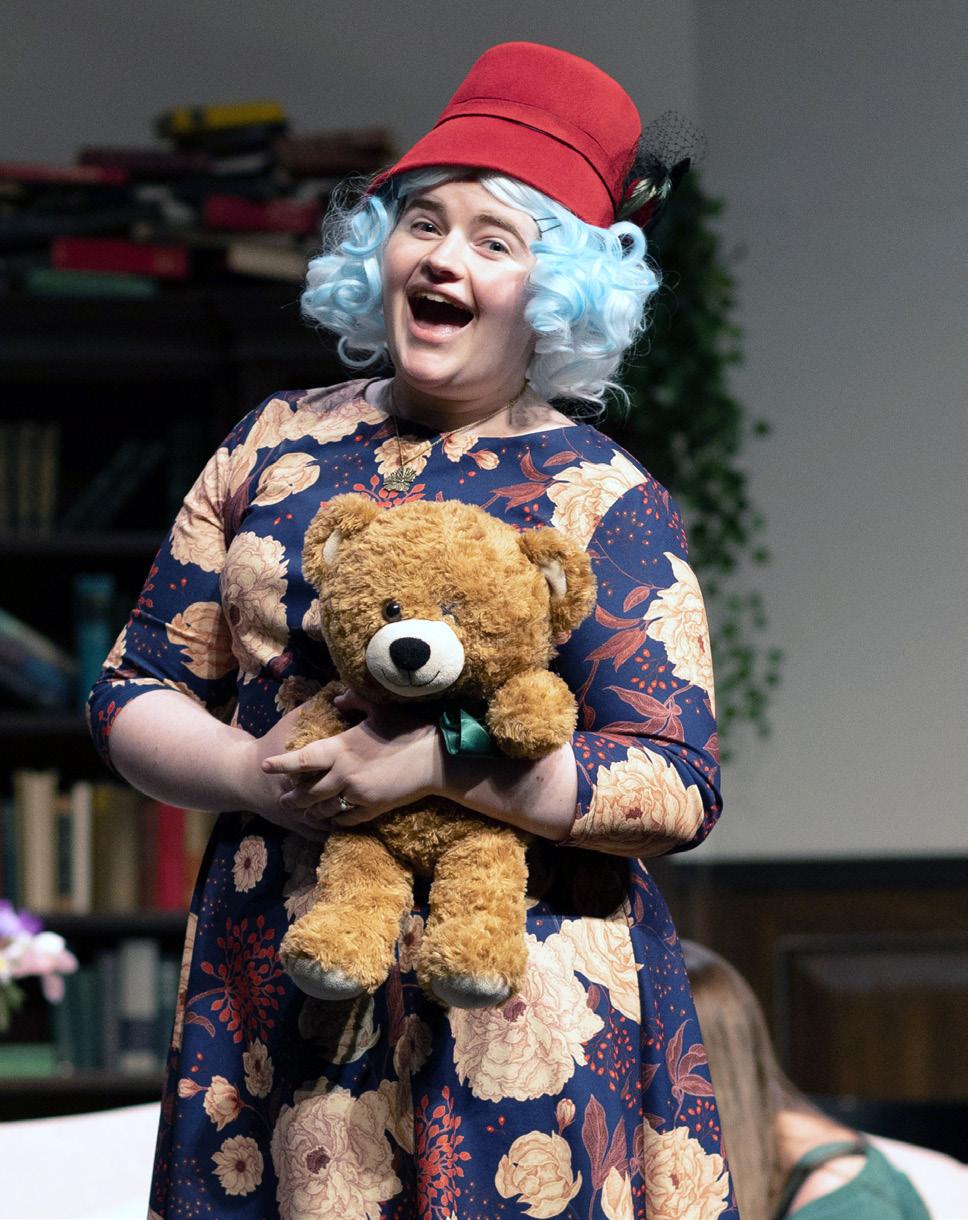
“[The play] is more lenient and a little less stressful than the musical,” cast member and freshman Jonas Viskanta said.
But just because it was a more chill experience, does not mean that progress was not been made over the short time they have to rehearse.
“It’s a process like any big project,” Morario said. “Being able to see on this week, it was really bad, and then two weeks later this scene is really better, this moment is way clearer.”
But to get to the final show day, it was not just rehearsing. What the audience doesn’t see is the hard work of the crew behind-the-scenes, which consists of set designers, costume makers, make-up artists and more.
“There’s painting, construction, advertisement, costumes, hair, makeup, and props,” Morario said.
Being able to see the show come to life was a huge deal for all members of the cast and crew.
“It’s just really awesome to be a part of a story like that and see it come to life,” cast member and senior Amelia Schaffer said.
The play was an opportunity for previously novice actors to make a debut or
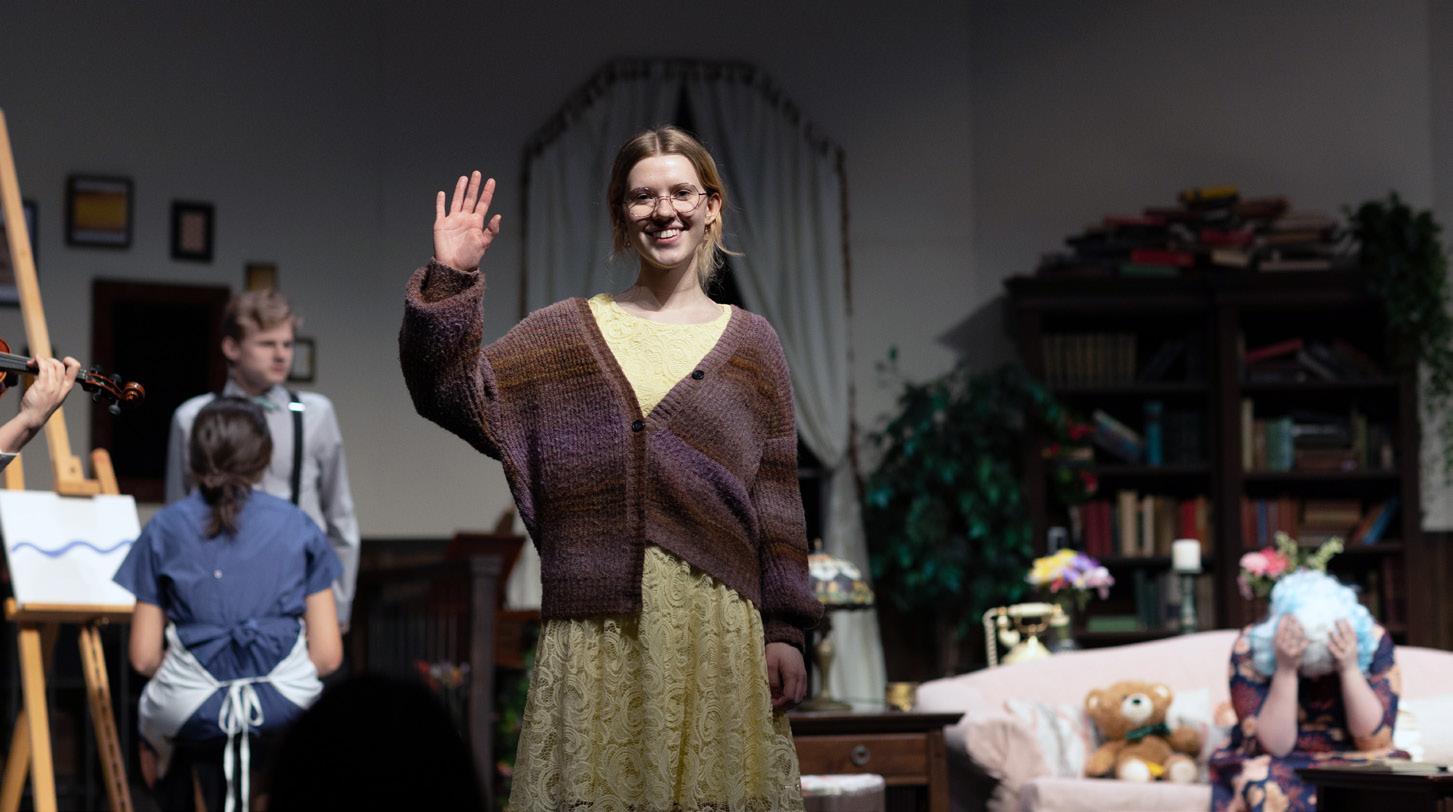
already experienced actors the chance to add to their resumes. But no matter that level of actor, being in front of so many people can be nerve-wracking.
“Remember when you’re acting that it’s not really you,” Steinburg said. “You’re taking on a different persona.”
Overall, Schaffer said the community and experience of the play was very welcoming, connective, and inclusive.
“My favorite part of acting is the community that it creates,” Schaffer said. “You might not necessarily interact with a lot of these people at school, but during rehearsals, you really bond while creating this show that everyone loves and wants to succeed.”
The spring play featured mischief, mayhem, and loreBottom: Amelia Schaffer, senior, plays Fairy May in the play on opening night, April 13. Photos by Lauren Burch Margaret Williamson, junior, plays Mrs. Savage in the play on opening night, April 13.
Junior Diego Velazquez can be seen wearing unique and earthy jewelry, including necklaces, bracelets and rings.
Velazquez said his style has an “earthy vibe”, and when looking for jewelry, rocks and crystals seem to always catch his eye.
In his elementary years, Diego describes looking through his mom’s jewelry and how he’s “always had an eye for jewelry”. While he enjoys looking for jewelry and finding new things,
Senior Hannah Patrick says that her handmade jewelry gives off an “Earthy vibe.” The wire wrapped crystals and strings of beads can be spotted all around the school worn by her biggest supporter.
“My sister [Maddie] is like a walking model for my [jewelry],” Patrick said. Her interest in jewelry making sparked during her time at home during the pandemic. What started as a way to pass time
Junior Hannah Patel has “always been creative”, but started to express that through jewelry making earlier in her high school career.
“I have always been into making jewelry, but as a business I really started sophomore year,” Patel said.
What started as creating designs consisting of assorted beads and string has broadened into a jewelry business.
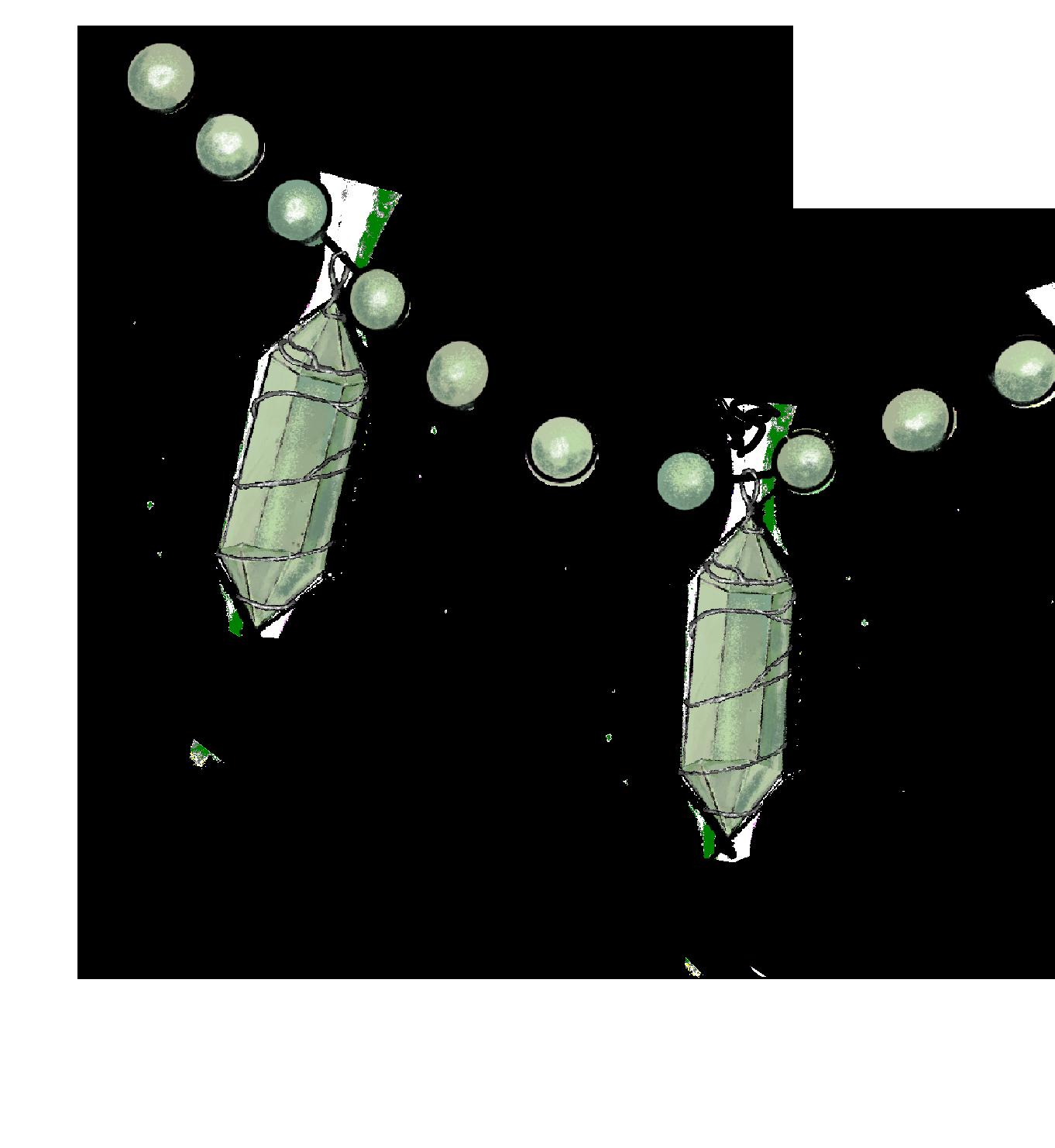

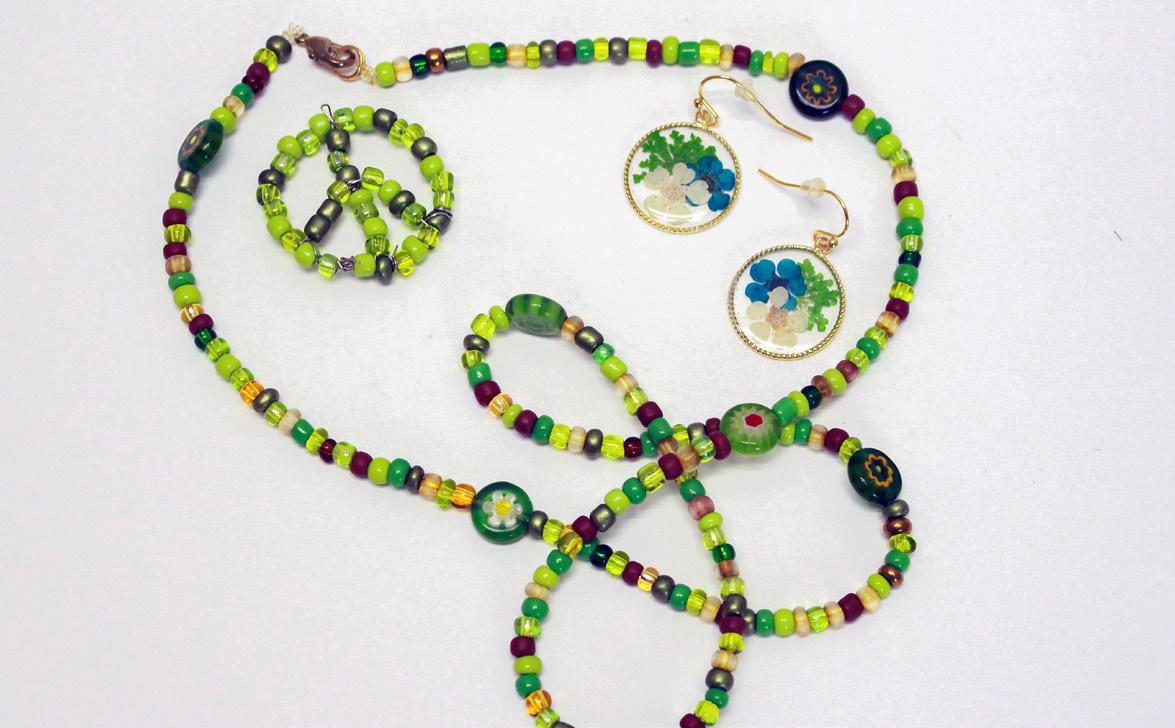
To get her business going, Patel made a bunch of jewelry and advertised what she had made.
Patel also makes personalized jewelry which she describes to be
Valezquez usually sticks to his favorite pieces.
“Personally, I wear the same jewelry over and over again,” Valezquez said.
Valezquez’s favorite piece of jewelry is the wire wrapped crystal necklace that his best friend gave him. “I will never take it off because of how special it is to me,” Valezquez said.
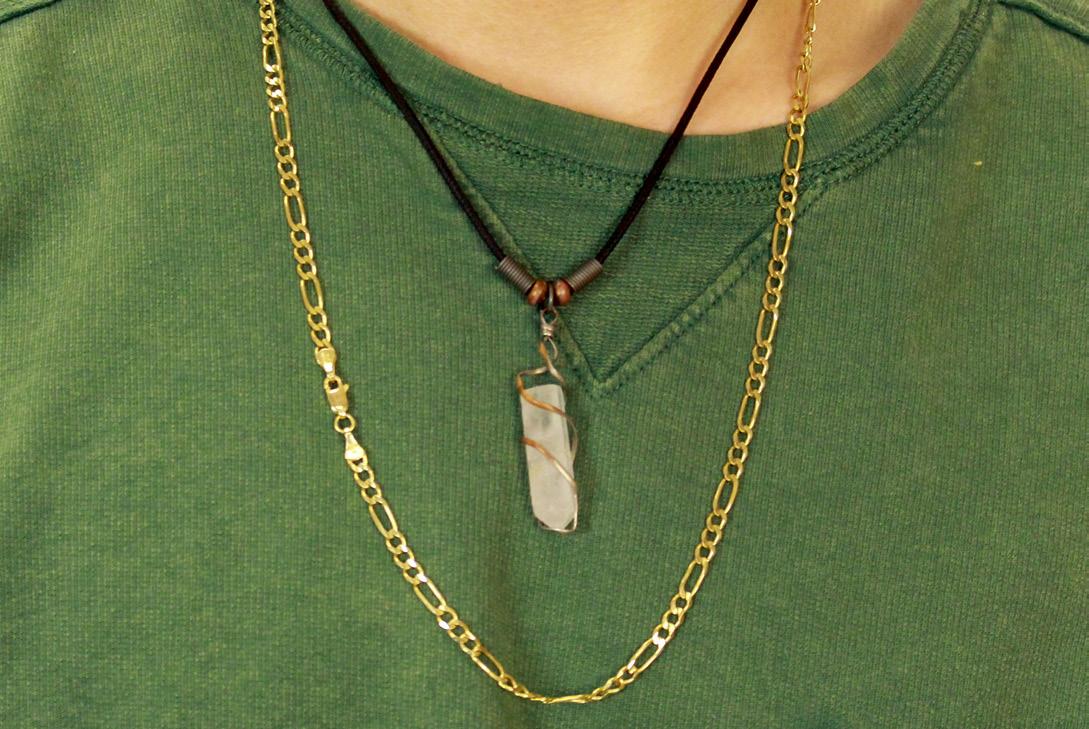
alone has blossomed into a form of expression.


“I’ve always been a really artsy person,” H. Patrick said. Although she was successful in selling her jewelry, she decided to stop after about a year.
“It’s more of just an enjoyable hobby now.” H. Patrick said.

“more fun” because she can combine her creativity with others’ ideas.
Patel said she enjoys creating and selling her jewelry; she sees this activity as a hobby, but imagines that it could go further.
“When I’m older I might want to do something with art and jewelry making is art, so it’s a way I can do that now,” Patel said.
To acquire design ideas and styles, Patel enjoys going to antique stores and unique places where she can find one of a kind jewelry that’s not seen everywhere.
Hannah Patel
Some appear flashy, some unapproachable, but all take a risk and step out of the box. Onlookers critique or appreciate, the eye rollers and admirers alike. But despite sharp glances crossing their path, the “overdressed” take pride in their chosen outfits.
Overdressing is a phenomenon that’s surfaced in recent years among high school students and young adults. It’s a loosely defined catchall term for dressing up or putting together a coordinated outfit for occasions that wouldn’t need it.
The meaning of the word overdressed has shifted over time. It once meant to be too formal for the occasion, but nowadays overdressing is commonly used to categorize people who step outside of normal clothing conventions. This definition has grown out of a social understanding of overdressing. Merriam-Webster defines overdress as “to dress and adorn in excess.”
Because overdressing is a term thrown around so freely, what exactly does it mean to Zionsville students? What is the line between formal, draw -
ing attention and just wearing an outfit with time put into it?
“When people say like, ‘oh, you’re overdressing,’ they’re usually just out of the norm,” freshman Anna Moenning said, while wearing a tank tee and men’s boxers for shorts. “The people who put on outfits every morning are treated like that just because not everyone is dressing to show out.”
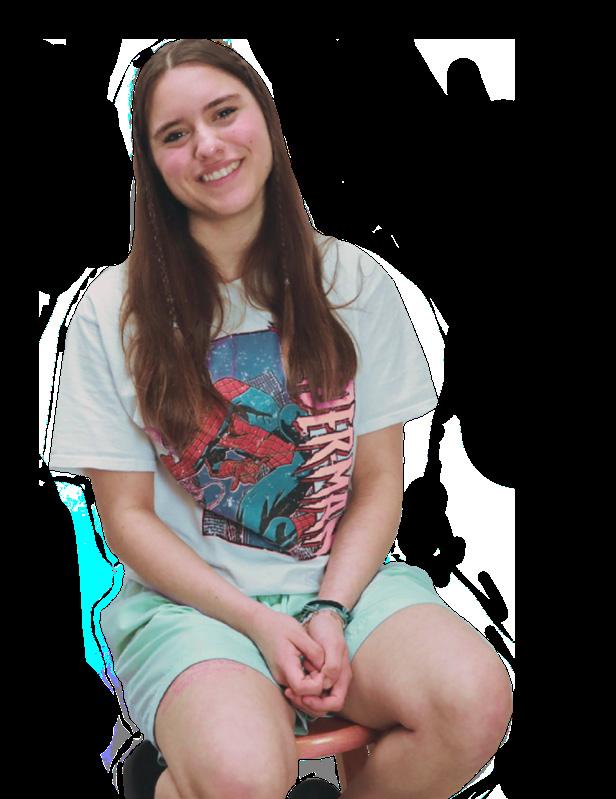
The desire to experiment with clothing has had a spike in popularity since the pandemic but there is a still an underlying pressure to not stand out.
“While we’ll always love a good trend, the pandemic has allowed people to dress for themselves despite trends,” Jasmine Fox-Sulaiman, editor of the website whowhatwear.com said.
With the dry period of social interaction that was the Covid-19 quarantines, naturally the return meant a greater amount of people experimenting with clothing because of the freedom that came to many teenagers at that time.
Junior Dylan Anderson notes that the bar is still low for the standards of uniqueness to the average person.
“I think underdressed students can feel scared of expressing themselves through extreme clothing,” Anderson said, while wearing dress pants, a thrifted vest and a colorful polo shirt from his mother.
The dogmatic mindset that pulls high school students into this status quo is apparent to some but felt by many as well. The fear of
being ostracized for trying something new or diverging from the norm affects students before they even notice.
“I’ve had instances happen at the school that have all out stopped me from wearing skirts, which since I identify as male can be seen as overdressing,” Anderson said. “Very rarely I’ll care what other people think, except in cases of extreme harassment where I’ve felt like I’ve had to completely stop wearing something.”
Although the majority don’t dress up for school, even students who feel unaffected by the judgment of their peers still see it in the halls.
“If I feel like wearing something, then no matter who says something I’m still going to wear it,” sophomore Schmidt Pierrot said while rocking skinny jeans and a graphic tee hidden by a sleek puffer coat. “I see people who will go ‘oh you’re doing too much’ but it isn’t really up to anyone else if you like your outfit or not.”
A lot of students do step outside of the box when not in school. Does this mean school can become a concentration of watered-down outfits based out of anxiety and hive mentality?
“I always feel like if I want to dress up [at school], I have to ask someone else to dress up with me, so I don’t feel like I am by myself,” Moenning said.
Though there isn’t a streamlined answer to the acceptance of style in school, it should be acknowledged that these students who “dress to impress” take control of people’s perception of them by unapologetically being themselves.
“I see people who judge all the time,” Pierrot said. “Let someone have their moment.”
The days are getting longer and the weather is getting warmer. The afternoon sun’s warmth is replacing the crisp feeling of icy air. The sounds of chirping birds are calling nature-loving students out to explore.
“When I hear, ‘the great outdoors,’ I think of out west; the Rocky Mountains come to mind. I think of it like this vast landscape full of wildlife,” Ian Seward, senior, said. “One way to get outside is to search for parks around the area; that’s something I do with friends. When we are bored in the summer, it’s a great way to spend a few hours.”
Although our midwest town might not offer the same “vast landscape full of wildlife” that the Rocky Mountains might bring to mind, there are endless ways that locals can enjoy the outdoors.

“Indiana is beautiful, too,” Sophia Larsen, junior, said. “Turkey Run, that place is fun.”
Turkey Run is one of two nearby state parks. Its deep canyons, rushing waterfalls, and buzzing wildlife can make anyone feel like they are exploring untouched terrain halfway across the world when in reality they are just a little over an hour’s drive west of Zionsville.

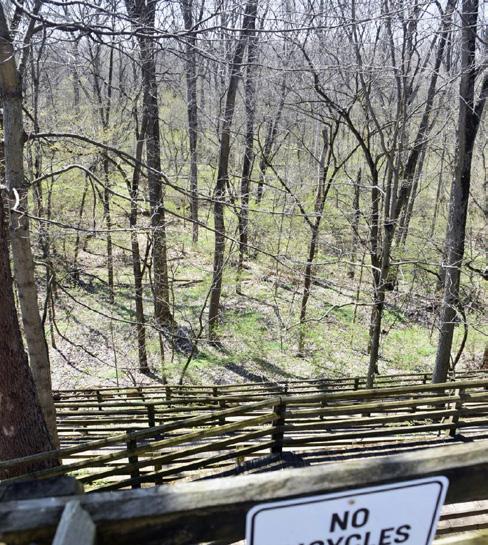
But, if Turkey Run is still too out-of-the-
way, there are several smaller parks conveniently close to residents.
“Zionsville has a lot of parks like Starkey Park, Elm Street Green, and Lions Park,” Ailia Benson, sophomore, said. These local parks offer a variety of trails, playgrounds, bodies of water, and outdoor activities. They are also public, which means that everyone can partake in everything they offer.
“One spot I really enjoy going to is Eagle Creek Park. It’s so fun to get out there and hike,” Seward said. “The people there are always so nice and it’s pretty big so you can spend a lot of time there as well.”
Although Eagle Creek is owned by the city of Indianapolis. Any Boone County residents can get in for $6 per vehicle.
Although the parks offer great opportunities to connect with nature and hike through forests, sometimes simply going outside can mean just that: going outside.
“We’ll play sports at Mulberry Fields or play pickle-ball at the new main street park,” Larsen said. “It’s fun to be outside even if it’s not like the ‘great outdoors.’”

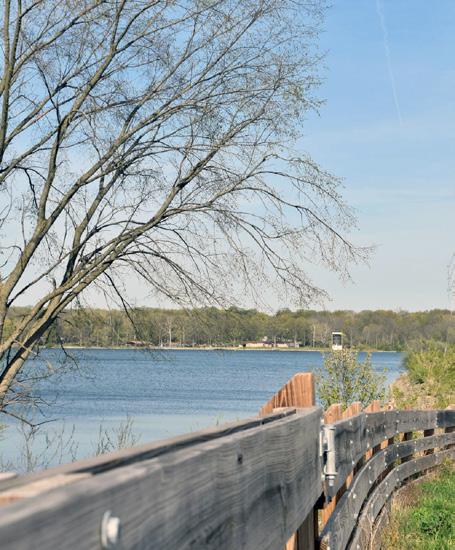
The first step is walking out the door and breathing in the fresh air, and after that what you choose to do is up to you. There are countless benefits to just being outside.
“This is not for everyone, but sometimes
I kind of love going on a cold run. When you breathe in the cold air, it makes you feel alive,” Lauryn Herbon, junior, said. “I think that being trapped in your house declines your mental health so much because you feel so isolated.”
Many other students have also felt the impact nature can have on their mental health.
“I find being outdoors appealing just because it calms me down so much,” Seward said. “With technology, we tend to lay around and just soak up what’s on our phone. But when I go outside, I find myself way less stressed and I get more fulfillment from being outside than scrolling on my phone.”
Whether it’s by running, hiking, or playing pickleball with friends, it is especially important for teenagers to seek the benefits of the outdoors.
“It’s a positivity boost,” Larsen said. Breathing in the aromatic air of blooming flowers can be enough to bring joy to a bad day. Hearing the sounds of laughing neighbors on their front porches and kids at play often reminds us that we aren’t as alone as we might have felt during the disconnecting winter months. So as summer approaches, step outside.
Summer starts off relaxing and refreshing. But slowly, as the days tick by, this changes. You start going to bed later and sleeping longer, and the days start to blur together. The consistent structure given by school is lost to the monotonous days of summer.
Having break time in your schedule is important, but having consistent structure is needed to help you maintain a healthy and productive schedule. Over the summer I’m not thinking about what I learned throughout the school year. I think students tend to view summer as a time to stop learning and relax, which is one of the great parts about summer, but this can make people regress in their learning.
School not only provides stability, but physical resources such as food and counseling.
Students who use school resources and confide in teachers, counselors, or other trusted adults throughout the year are left without those supports during the summer, which can be damaging to students’ physical and mental health.
Some students also face issues with their additional mental health over the summer.
The switch from having a regular routine during the school year to the instability of summer can be harmful to people’s mental health. You lose the consistency of routine and can get stuck in a rut. It can be hard when you control your own schedule to identify priorities, such as time for yourself or physical activity.
It can be hard for people to recognize when I feel down, especially over the summer. I feel more isolated and not productive.
Over the summer it can be easy for mental health to fly under the radar. People around you don’t notice changes in your routine that could indicate you’re struggling. You also aren’t around your friends who could notice when you are struggling. Indicators of depression, anxiety, and other mental issues could be seen as just relaxing over summer, like sleeping in or staying in your room.
Over the summer, after I lose my routines, the days slowly blur together. Consistent routine can be vital to maintain a positive state of mind.
There are many small routine changes, including changes in diet and meal times.
Consistent schedules also help people eat enough, and during the school year students eat on a mainly consistent schedule. Over the summer, it can be easy to forget to eat and drink enough or eat and drink too much. This is not only harmful to your physical health but your mental health.
Mara Podshadley, freshman, says that keeping a schedule helps her plan out her day so she can have structure throughout her day.
When I make a schedule I feel more pro-
ductive and I get more done which helps me feel more accomplished. Keeping a schedule can help people get through everything they want to. It can help people have a more productive summer and improve mental health.
Good physical health is also a necessary when it comes to maintaining good mental health
The National Library of Medicine says that levels of physical fitness and obesity are thought to affect people’s psychological wellbeing. Poor physical fitness can result in low self-esteem and depression, whereas higher self-esteem gives a layer of protection from the impact of negative influences which ultimately helps them choose to stay in better physical health.
Overall, students need to take their mental health into their own hands. By building consistent routines for themselves, they can work to have a productive and relaxing summer.
“Your summer isn’t fulfilled if you don’t keep a schedule.” Podshadley said.
Taking care of yourself is the best way to fully enjoy your summer and get things done!
Sometimes you have to take your mental health into your own hands. Reaching out to trusted friends and adults as well as going to in person or online counseling can help. Resources like Bette.rHelp and Open Counselling can connect you with free or affordable online services. You can also find support groups near you.
Preventing learning loss can be possible by taking summer school classes to get a jump start on the next year or even just reading regularly.
Outdoor time
Getting outside can help you feel more connected to the world around you. Being outside can help you stay calm and active
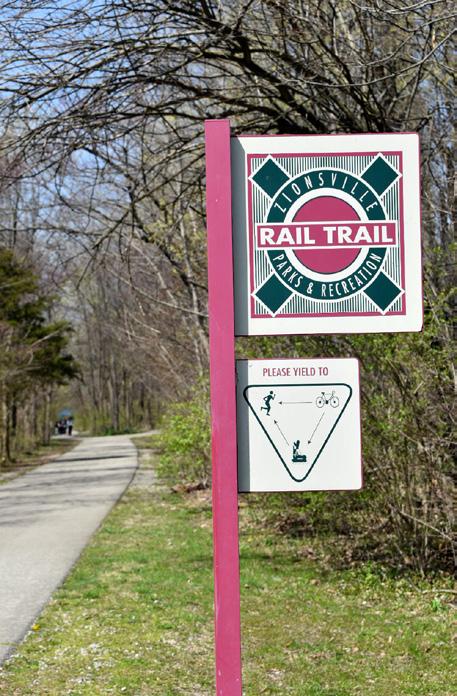

Make sure to put yourself first and schedule time to reset and relax. Put your mental health first!
Creating a routine can help you maintain the stability school provides and setting goals can give you motivation throughout the summer.
Finding, keeping a routine in the summer is keyPhoto by Brooklyn Brown. Photo of a river taken at the Rail Trail on Easter. A Rail Trail sign at the Rail Trail taken on April 9. Photo by Brooklyn Brown
All kinds of students fill the halls of Zionsville. Athletes, artists, band kids, show choir performers and honor roll students can all be found in the crowd.
But what about those kids you might not know about? The “weird” kids, the “emo” kids, “nerdy” kids, or even kids who don’t really talk at all and seem to blend into the background? They all have a story to tell.
Resource rooms exist in almost every school as a space where students can receive extra support in school and life. Students who struggle with learning and emotions also exist at every school. They go to class, eat lunch, and hang out with friends just like everyone else. But misconceptions and stereotypes often follow wherever they go, making it hard to exist comfortably with their peers.

This begs the question: what do these peers really know about the other students they share spaces with every day?
“Olivia,” a sophomore who wishes to remain anonymous, is a student in the “Intense Intervention” (II) classroom, a room for students who struggle with managing their behavior and need more support than what is offered in a standard “Academic” Resource room.
Olivia describes Resource as a “chill” area to calm down and spend time away from the stress of school. She says that other students don’t really know her
“true self.”
“I’ve heard people say things like ‘Are you crazy?’ and some people say the R slur and stuff,” Olivia said. “They just don’t understand. I get really irritated because most of the time, those [assumptions] are not at all true, and a lot of students who say things like that have friends who are in Resource classrooms and don’t even realize it.”
Many students in the II classroom have been made to feel bad by peers, often in moments of distress or agitation, and are rarely thought of in those situations as human beings who need help and care.
“I share the importance of there being a space for everyone, whatever they need, making sure those students have a space to break down and do their thing without having to worry about classmates wondering what they’re doing is essential,” the Unified Services department chair, who asked to be identified by her title only,
said. “They should get to heal and work through challenges [in a safe space].”
The Intense Intervention classroom is described as “improving instruction for students who have not responded to standard protocol,” according to the National Center for Intense Intervention. It is headed up by Sara Eisinger, who is in her first year here, though hardly her first year in Special Education. Eisinger says that one of the biggest things people forget about kids in Resource rooms is that the students in those spaces are just that: students.
“They get labeled as their behavior and not as people,” Eisinger said. “It’s a
common misconception that the people in here don’t have interests and hobbies and aren’t capable of enjoying things like anyone else.”
Olivia agrees with this, saying that she enjoys talking to friends.
“We all like normal teenager stuff,” Olivia said. “We want to fit in, we want to belong somewhere. We all want to just be chill and have other people think of us the same way they would think of other kids.”
One sophomore in II says they enjoy reading, drawing, and playing guitar. Another student in Behavior Resource works at her family’s shop and likes to draw and play games.
As mental health struggles in teens are on the rise, the need for empathy and understanding is more important than ever, especially in school environments. Some II students feel that they get pushed aside when people judge their situations without knowing the full story.
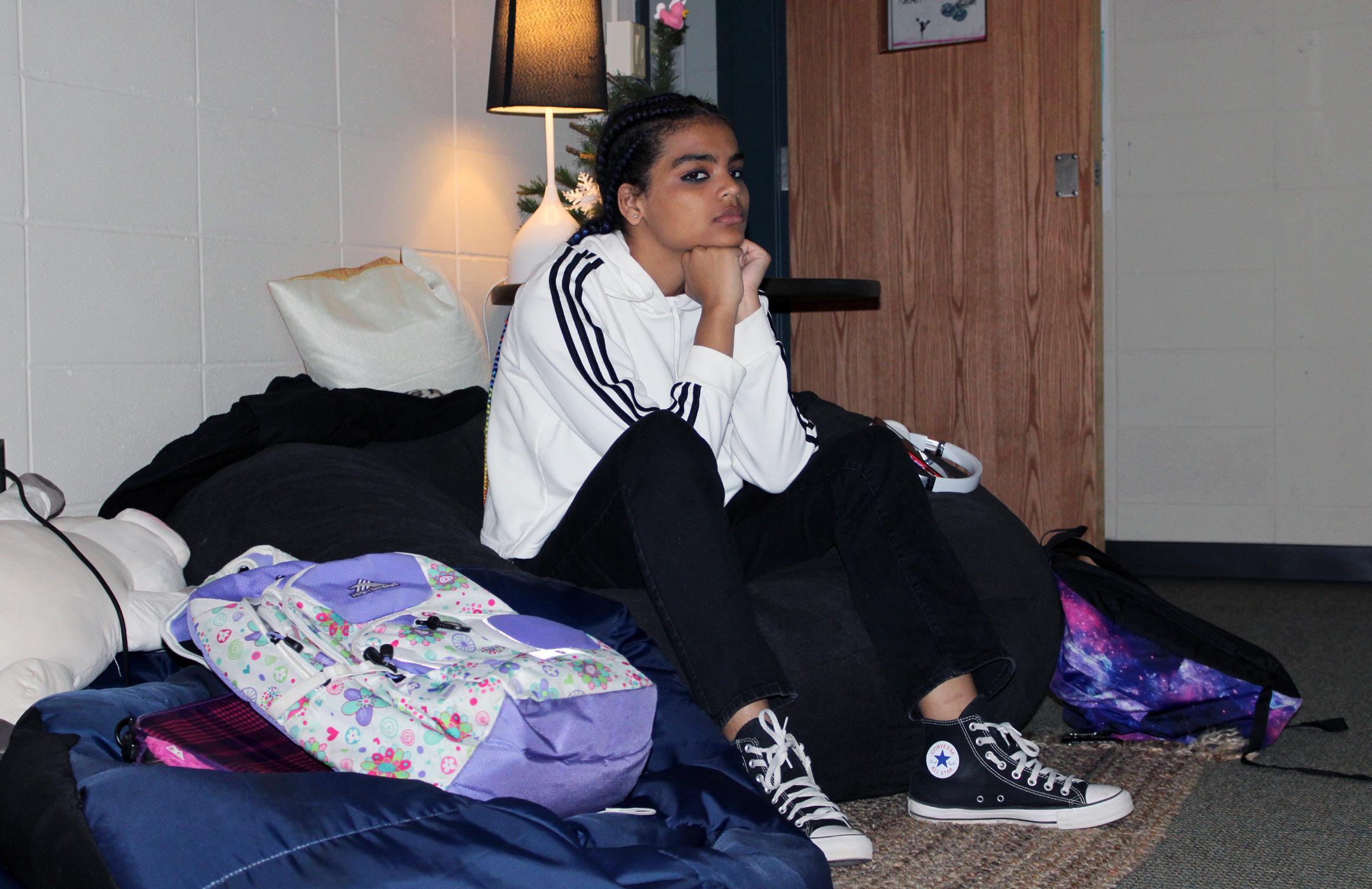
“I would say the most common misconception is that they are ‘bad’ kids,”
the Unified Services department chair said, making a point to stress that she used air quotes on the word bad. “Or that they are just ‘kids who get in trouble.’
It’s important to me that Zionsville has a room where every single person feels like they belong.”
The Unified Services department chair’s hope has always been that someday there won’t even need to be programs for Special Education because “we would just give kids what they need”, making all education fully inclusive and equitable.
Eisinger said that even people who are qualified can mishandle situations with students, especially when emotions are involved.
“It’s very hard not to take things personally and to realize that behaviors are a way of communicating,” Eisinger said.
“It’s important to listen even when those behaviors are happening.”
The students in classrooms like II want people to know that they have feelings just like everyone else. Olivia said that she would feel more accepted and heard at school if Resource was more normalized.
“Other kids don’t really understand the point of it,” she said. “It’s reputation is kind of like ‘oh they’re crazy, they’re mentally ill’, and stuff like that, but that’s not the point. That’s not who we are, and that’s not what we do.”
Eisinger said that the best thing about working with these kids is not limited to just one.
“The personality differences and just the light that [students] bring into this room make coming here every day worthwhile.”
“We all just want to be chill and have other people think of us the same way they would think of other kids.”
- OliviaRahsha Muhammad relaxing in the Intense Intervention room at the end of a school day on April 28. Photo by Mary Demarco
Junior Hannah McKenna has had a love for projects ever since sixth grade with Mrs. Soel. The first project that McKenna fell in love with was a trans- mediation. The class got to run with whatever they wanted and take the project in a direction that they chose.
“I made a little jar and made a story that went into the jar,” McKenna said. “It was about Mesopotamia and got to make my own story about a made up boy who was living in a Mesopotamian society.”
One reason McKenna loved this project was because she got to apply all the many different materials she had learned.
Alternative assessments create a more understanding and deeper knowledge of the topic taught in classrooms. They also allow students to have better engagement and greater attention to details and creativity.
Baylor University states that alternative assessments offer new methods for students to explore a subject.
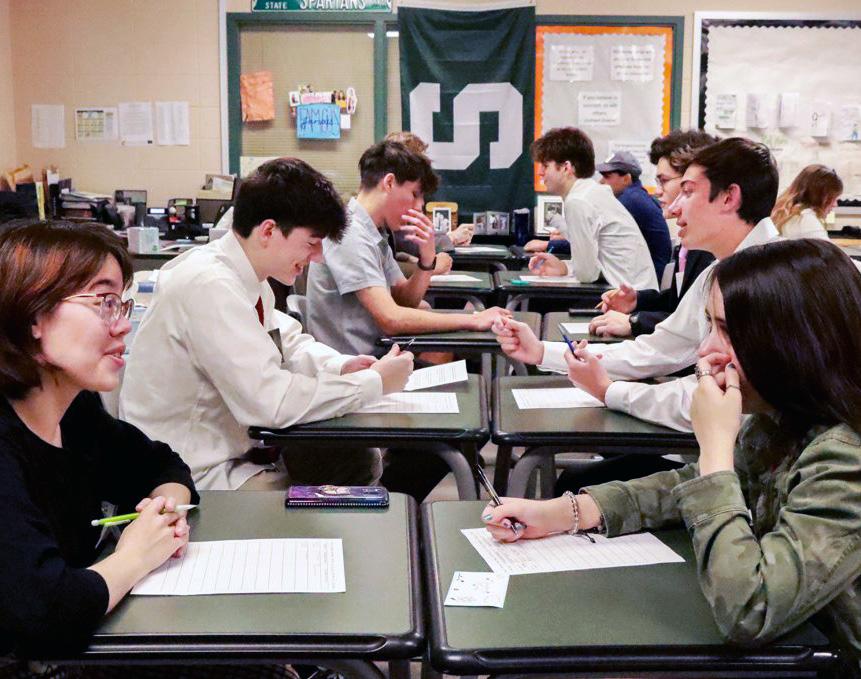
According to Baylor.edu, “moving away from traditional forms of assessment is becoming more common practice, and highly desired, by students, teachers, and the professional world to extend the life of assessments past a single moment. Alternative Assessments may offer new ways for students to explore subject matter in unique, and holistically beneficial ways.”
Here at ZCHS some teachers have decided to choose a project over a test for similar benefits that Baylor.edu described as a “holistic experience.”
Michael Szymusiak, math teacher, says that there are certain things that are easier to assess with a project.
“[In finite math class] we’re doing matrix (which is a class that focuses on patterns and how numbers can be applied to coding) right now and you need more than a normal calculator,” Szymusiak said. “Instead of making people buy calculators, we’ll do a project and you can use whatever you need for it.”
Not only do projects create less anxiety, but they help students understand subjects at a more nuanced level.
Along with this, replacing tests with projects has significantly reduced anxiety in students. History teacher Brandon Mooradian said, “Immediate stress level is much lower than it would be for a standardized test or a regular test.”

Not only do stress level’s decrease but body language changes.
“I think there’s less anxiety involved,” math teacher Michael Szymusiak said. “You see body language is different and even when you call something a quiz at times, kids start
to tense up and act differently versus saying ‘here’s an assignment or a lesson check’.”
“There are a lot of times where you can get deeper into some thoughts with projects versus what we can do in a standard 15-minute period of a test,” Szymusiak said.
Szymusiak likes these projects because students can take their own direction. For example, students can pick what data they use. When this comes into learning, then the students get to take ownership of what they are doing and find interest in it. Allow students to execute functioning skills that are necessary for adulthood.
Mooradian has noted that many students who are more successful with projects tend to do better after high school.
Students who are good at project based learning create their own plan. Then, create steps to solve that plan and have a solution at the end.
“Project based learning focuses on more than just achievement levels of education and knowing facts and basic knowledge.” Mooradian said. “It also focuses on executive functioning skills that are necessary for adulthood.
Some examples that Mooradian’s US history class does as alternative assessments are taking sitcoms then infuse them into a historical era and then make a video about it. Aside from this, In AP US History students have a service project. This allows the students to go above and beyond the normal achievement levels of education.

11 May Varsity Softball Game against Lawrence North High School
When: 6 p.m.
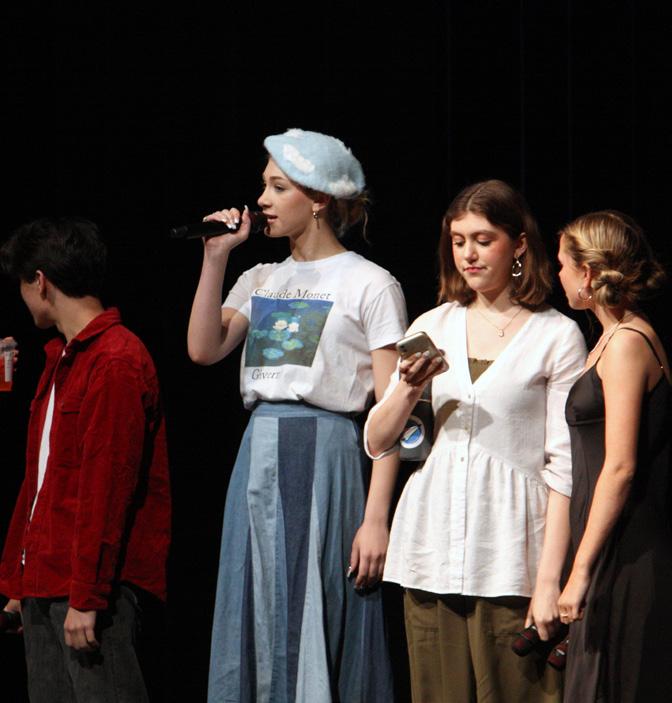
Where: Varsity Softball Diamond
17 May Boys Lacrosse JV & Varsity games against Carmel

When: 5:30 p.m.
Where: ZCHS
15 May Girls Tennis
JV & Varsity games against Brebeuf
When: 5 p.m.
Where: 875 Sports Complex
18 May Varsity Baseball Against Noblesville

When: 6:30 p.m.
Where: Varsity Baseball Diamond
16 May Track & Field Girls Sectional meet
When: 5:30 p.m.
Where: ZCHS Stadium
25 May Last Day of School